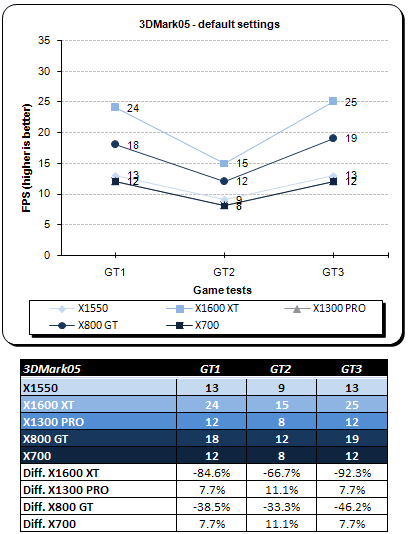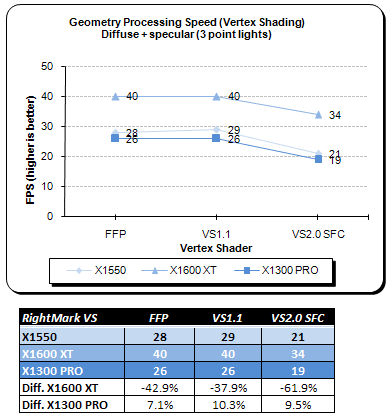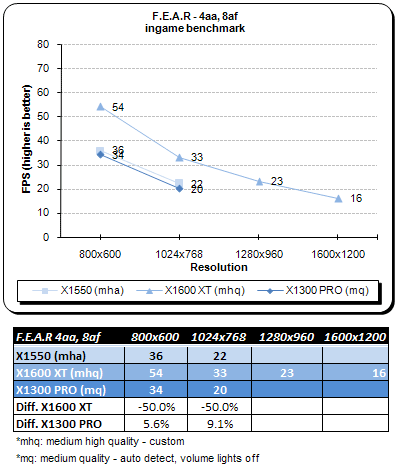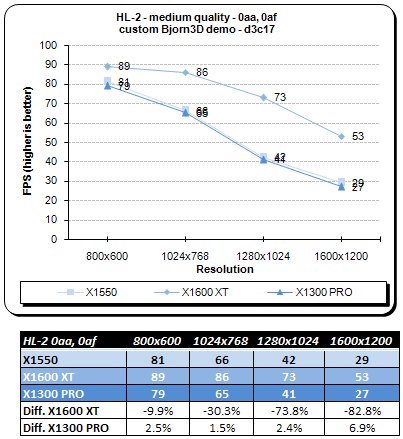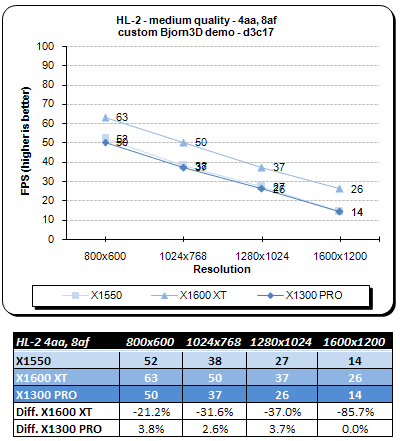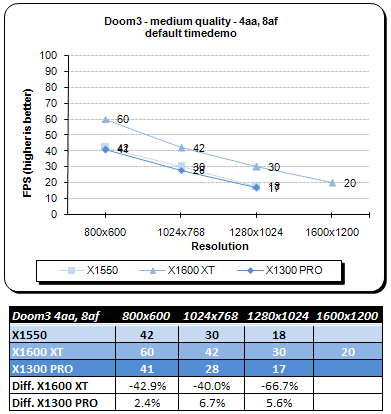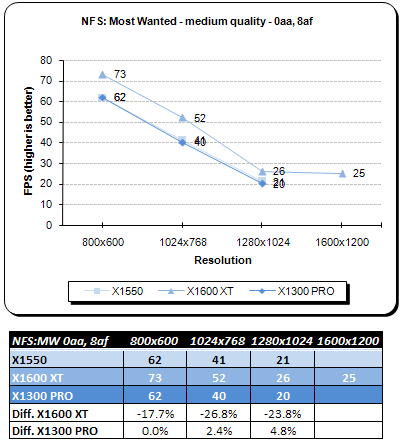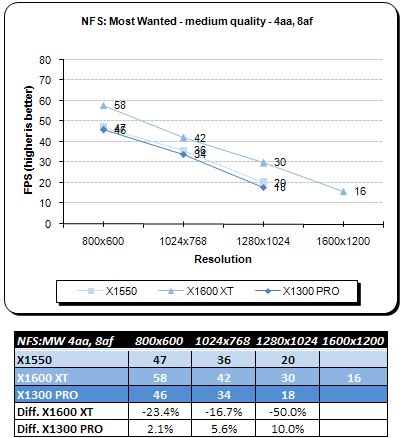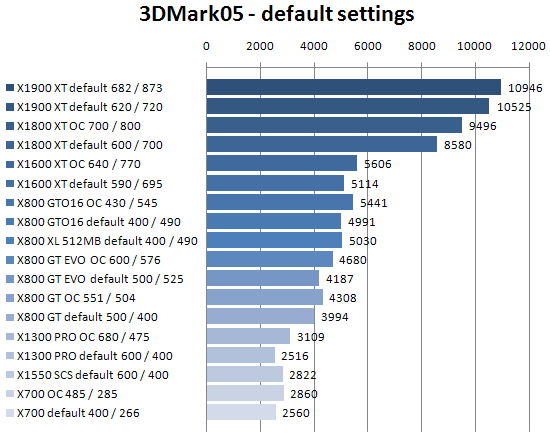This product is intended for folks with less gaming on their minds. The fact is, I would advise against getting this rebadged X1300 RADEON for your SFF / HTPC system due to high temperatures. It’s okay for your parents / grandmother PC, but that’s about it.
Introduction
Taipei, Taiwan – January 17 th , 2007 – TUL Corporation, a leading provider of AMD/ATI graphic cards, today announced the PowerColor X1550 in PCI-E, AGP and Silent Cooling System (SCS) variations. These models replace the X1300 brand in an effort to re-emphasize the complete support of AMD/ATI-based graphic cards for Windows Vista™ platform; particularly for the entry level segment. PowerColor’s X1550 comes with a factory overclocked core of 600MHz, with memory speed of 400MHz (800MHz effective) and 256MB of DDR2 RAM.
Every now and then companies will introduce products that carry no real change except for a product name. ATI have had few of those in the past, for example X1650 PRO which is a renamed X1600 XT. This is the case here where old X1300 PRO gets new pants and inherits a new name: X1550. It’s an old IHV (Independent Hardware Vendor) trick to get rid of old SKUs and bring them back into the market through various channels. Believe it or not, product naming scheme does play a major role in consumers’ minds. Potential customers will think this way: X1550 > X1300. Logically, 1550 is bigger than 1300; and because bigger means better for some people, why not go and buy it? I will spoil the fun just a little. In our case X1550 = X1300 PRO and have that equality running through your brain throughout this review, period.
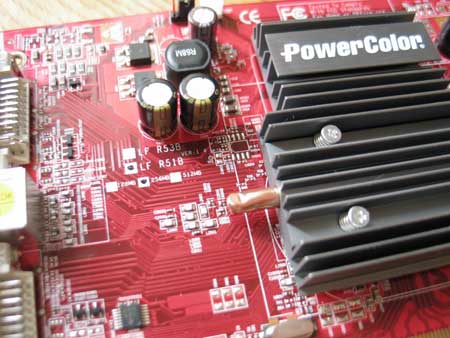
What I have here for you today is already mentioned RADEON X1550 from PowerColor with “SCS” suffix (Silent Cooling System). Because it runs silently I will treat it as an ideal solution for your HTPC. Let the fun begin!
Should you require more detailed information on X1K please revisit our article: The X1000 series – ATI goes SM3.0
PowerColor is a consumer brand focused on providing cutting-edge graphics card products to retail customers. Our goal for the Tul brand is to be the industry’s number one provider of technology product solutions. Our goal for the PowerColor brand is to be the world’s number one brand of graphics cards. PowerColor is in effect owned by Tul Corporation, however the brands are operated independently of each other.
VPU Specifications
As with every new generation of GPUs the feature set becomes larger and more complex. The X1000 line sports Shader Model 3.0. The X1550 GPU is basically an X1300 manufactured using the same 90 nm process. It uses a 128-bit memory bus and comes with the same pipeline architecture. While most specs can be found here, let me just recap some of them here. RADEON X1300 / X1550 (RV515 / LE) can process up to 128 threads, 1/4 of what R520 can do. It sports 4 ROPs (no double-Z, however), 4 texture units as well as 4 shader units and 2 vertex units. Pipeline configuration is as follows:
- 4 Texture Units
- 4 Pixel Shaders
- 4 ROPs
- 2 Vertex Shaders
Important note: X1300 / X1550 GPU does not carry a Ring Bus! It uses different technique to improve memory allocation.
The rest stays the same, more detailed information right below
| Video card | PowerColor X1550 | PowerColor X1300 PRO | PowerColor X1600 XT |
| GPU (256-bit) | RV515 | RV515 | RV530 |
| Chip Architecture | .09µ (TSMC fab) | .09µ (TSMC fab) | .09µ (TSMC fab) |
| Transistors | ~105 Million | ~105 Million | ~157 Million |
| Memory Architecture | 128-bit | 128-bit | 128-bit |
| Frame Buffer Size | 256 MB GDDR-2 | 256 MB GDDR-2 | 256 MB GDDR-3 |
| Pipeline architecture |
4 ROPs 4 Pixel Pipelines 4 Pixel Shader units 4 TexUnits 1 full, 1 mini ALU unit 4 Z-samples / clock |
4 ROPs |
4 ROPs 4 Pixel Pipelines 12 Pixel Shader units 4 TexUnits 3 ALU units 8 Z-samples / clock |
| Vertex Pipelines | 2 | 2 | 5 |
| TMU(s) per Pipeline | 1 | 1 | 1 |
| Engine | Ultra-threaded architecture | Ultra-threaded architecture | Ultra-threaded architecture |
| Bus Type | PCI-e 16x | PCI-e 16x | PCI-e 16x |
| Core Clock | 600 MHz | 600 MHz | 590 MHz |
| Memory Clock | 400 MHz | 400 MHz | 690 MHz |
| RAMDACs | 2x 400 MHz DACs | 2x 400 MHz DACs | 2x 400 MHz DACs |
| Memory Bandwidth | 12.8 GB / sec | 12.8 GB / sec | 22.1 GB / sec |
| Pixel Fillrate | 2.4 GPixels / sec | 2.4 GPixels / sec | 2.36 GPixels / sec |
| Texel Fillrate | 2.4 GTexels / sec | 2.4 GTexels / sec | 2.36 GTexels / sec |
| Geometry rate | 300 MTriangles / sec | 300 MTriangles / sec | 738 MTriangles / sec |
| DirectX Version | 9.0c | 9.0c | 9.0c |
| Pixel Shader | 9.0c | 9.0c | 3.0 |
| Vertex Shader | 9.0c | 9.0c | 3.0 |
- Features
-
- 105 million transistors on 90nm fabrication process
- Four pixel shader processors
- Two vertex shader processors
- 128-bit 4-channel DDR/DDR2/GDDR3 memory interface
- 32-bit/1-channel, 64-bit/2-channel, and 128-bit/4-channel configurations
- Native PCI Express x16 bus interface
- AGP 8x configurations also supported with external bridge chip
- Dynamic Voltage Control
- High Performance Memory Controller
-
- Fully associative texture, color, and Z/stencil cache designs
- Hierarchical Z-buffer with Early Z test
- Lossless Z Compression (up to 48:1)
- Fast Z-Buffer Clear
- Z/stencil xache optimized for real-time shadow rendering
- Ultra-Threaded Shader Engine
-
- Support for Microsoft® DirectX® 9.0 Shader Model 3.0 programmable vertex and pixel shaders in hardware
- Full speed 128-bit floating point processing for all shader operations
- Up to 128 simultaneous pixel threads
- Dedicated branch execution units for high performance dynamic branching and flow control
- Dedicated texture address units for improved efficiency
- 3Dc+ texture compression
- High quality 4:1 compression for normal maps and two-channel data formats
- High quality 2:1 compression for luminance maps and single-channel data formats
- Multiple Render Target (MRT) support
- Render to vertex buffer support
- Complete feature set also supported in OpenGL® 2.0
- Advanced Image Quality Features
-
- 64-bit floating point HDR rendering supported throughout the pipeline
- Includes support for blending and multi-sample anti-aliasing
- 32-bit integer HDR (10:10:10:2) format supported throughout the pipeline
- Includes support for blending and multi-sample anti-aliasing
- 2x/4x/6x Anti-Aliasing modes
- Multi-sample algorithm with gamma correction, programmable sparse sample patterns, and centroid sampling
- New Adaptive Anti-Aliasing feature with Performance and Quality modes
- Temporal Anti-Aliasing mode
- Lossless Color Compression (up to 6:1) at all resolutions, including widescreen HDTV resolutions
- 2x/4x/8x/16x Anisotropic Filtering modes
- Up to 128-tap texture filtering
- Adaptive algorithm with Performance and Quality options
- High resolution texture support (up to 4k x 4k)
- 64-bit floating point HDR rendering supported throughout the pipeline
- Avivo™ Video and Display Platform
-
- High performance programmable video processor
- Accelerated MPEG-2, MPEG-4, DivX, WMV9, VC-1, and H.264 decoding and transcoding
- DXVA support
- De-blocking and noise reduction filtering
- Motion compensation, IDCT, DCT and color space conversion
- Vector adaptive per-pixel de-interlacing
- 3:2 pulldown (frame rate conversion)
- Seamless integration of pixel shaders with video in real time
- HDR tone mapping acceleration
- Maps any input format to 10 bit per channel output
- Flexible display support
- Dual integrated DVI transmitters (one dual-link + one single-link)
- DVI 1.0 compliant / HDMI interoperable and HDCP ready*
- Dual integrated 10 bit per channel 400 MHz DACs
- 16 bit per channel floating point HDR and 10 bit per channel DVI output
- Programmable piecewise linear gamma correction, color correction, and color space conversion (10 bits per color)
- Complete, independent color controls and video overlays for each display
- High quality pre- and post-scaling engines, with underscan support for all outputs
- Content-adaptive de-flicker filtering for interlaced displays
- Xilleon™ TV encoder for high quality analog output
- YPrPb component output for direct drive of HDTV displays**
- Spatial/temporal dithering enables 10-bit color quality on 8-bit and 6-bit displays
- Fast, glitch-free mode switching
- VGA mode support on all outputs
- Drive two displays simultaneously with independent resolutions and refresh rates
- Dual integrated DVI transmitters (one dual-link + one single-link)
- Compatible with ATI TV/Video encoder products, including ATI Theater™ 650
- High performance programmable video processor
* ATI’s Radeon™ X and Radeon™ 9550 series of GPUs are capable of processing HDCP signals (“HDCP ready”), however ATI does not presently manufacture any graphics cards which are HDCP ready. Some third parties manufacture graphics cards containing ATI Radeon GPUs — you can inquire of them which models, if any, — are HDCP ready.
**with optional HDTV adapter available from ATI Online Store
- CrossFire™
-
- Multi-GPU technology
- Inter-GPU communication over PCI Express (no interlink hardware required)
- Four modes of operation:
- Alternate Frame Rendering (maximum performance)
- Supertiling (optimal load-balancing)
- Scissor (compatibility)
- Super AA 8x/10x/12x/14x (maximum image quality)
- Multi-GPU technology
- HyperMemory™ 2***
-
- 2nd generation virtual memory management technology
- Improved PCI Express transfer efficiency
- Supports rendering to system memory as well as local graphics memory
- 2nd generation virtual memory management technology
The Card
We usually don’t review entry level cards, but since I’ve been given the opportunity I thought why not? The low-end segment is probably the most popular one. OEMs tend to put in their systems rather slow cards to cut the cost of the whole package.
Click a picture to see a larger view
What strikes you at first is the fancy cooling solution. PowerColor advertises it as SCS – Silent Cooling System which was previously slapped on PowerColor X700 and X700 PRO. The heatsinnk does not cover all RAM modules, worse they do not come in contact with the heatsink at all. For better heat circulation and dissipation, both heatsink blocks are connected with copper heatpipes. On the back of the card, PowerColor should have drilled holes for optional 60 mm fan in case the card runs hot — will see about that later on. This passively cooled solution looks promising, but can it deal with heat? Let’s move on. The card sports dual DVI-I outputs (not seen on many low-end boards so if you’ve got two LCD displays, you will be very pleased to use it) as well as TV-out. It carries a standard display support: VGA compatible, VESA compatible BIOS for SVGA and DDC 1/2b/2b+. As for onboard memory, PowerColor X1550 uses Hynix GDDR2 memory: HY5PS561621AFP-25 rated at 400 MHz inside 84Ball FBGA package.
Bundle
Click a picture to see a larger view
The front and back of the box highlight cards specifications and features. In the middle of the box you are presented with a hot chick with gun. The back of the box sports specs and some catch phrases. The sides show system requirements. Notice the Vista logo on top of the box. When you open up the white box you face the bundle — or at least you think it’s bundle.
Here is what should have been included (retail package includes what’s below). The above image shows what was inside.
Accessories
- Composite Cable
- DVI-I connectors
- Quick start manual
Software
- ATI drivers
Setup and Installation
All of our benchmarks were ran on a Athlon64 3000+ clocked at 2.5GHz. I will stack the PowerColor X1550 SCS against the other cards in the table below. Additionally I will throw in 3DMark05 scores from the X700. For the Overclocking section, it will consist of 3DMark05 scores from different cards. The table below shows the test system configuration as well as the benchmarks used throughout this comparison.
| Components | – DFI NF4 Ultra-D – Athlon64 3000+ Venice – G.Skill F1-4000BIU2-2GBHV DDR500 – Thermaltake Toughpower 850 Watt PSU – Thermaltake Mozart TX case (6 x 120 mm fans) – PowerColor X1550 SCS 256 MB – PowerColor X1300 PRO 256 MB – PowerColor X700 SCS 256 MB |
| Software | – Windows XP SP2 + Vista Business 32bit – DirectX 9.0c – nForce4 6.86 drivers – CATALYST 7.1 |
| Synthetic Benchmarks | – 3DMark 2005 v1.2.0 – D3D Right Mark 1.0.5.0 beta 4 |
| Gaming Benchmarks | – F.E.A.R / ingame benchmark + Fraps – Half-Life 2 / custom d13c17 timedemo + Fraps – Doom 3 / default timedemo + Fraps – NFS: Most Wanted / Fraps |
| Notes | CPU clocked at 2.5GHz |
Important CATALYST notes:
CATALYST A.I: advanced
Mipmap detail level: quality
As far as installation goes I cannot report any problems. The card booted without any glitches. All tests were done inside Thermaltake Mozart TX case with 6 x 120 mm fans to improve air circulation.
Synthetic Benchmarks
3DMark05
The cards throughput was measured using 3DMark05 application. I’ll be comparing it to X1300 PRO, X1600 XT and X700.
RightMark
D3D RightMark is a very useful tool for measuring different theoretical throughputs of a graphics chip. I ran couple of synthetic tests to stress out X1550 SCS. The main focus of theses tests will be to stress out Geometric Processing (Vertex Shading) as well as Pixel Shader units.
With D3D RightMark you will be able to get the following information about your video card:
- Features supported by your video card
- Pixel Fillrate and Texel Fillrate
- Pixel shader processing speed (all shader models)
- Vertex shader (geometry) processing speed (all shader models)
- Point sprites drawing speed
- HSR efficency
In this test, we are looking at the vertex shader’s (geometry) processing speed. I chose Diffuse + specular (3 point lights) for our lightning profile which is probably the most useful setting. This will give us peak geometrical throughput. In order to get a clearer overlook, three different shader profiles were used: Fixed Function Pipeline (FFP) VS1.0 and VS 2.0 flow control.
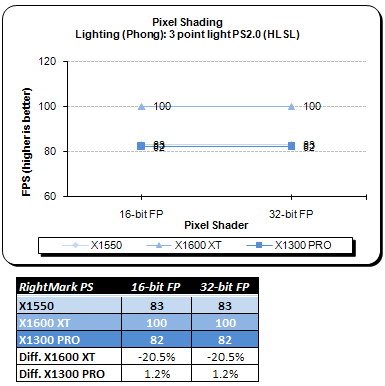
F.E.A.R
The game has been out for sometime now and is being admired by a lot of gamers all over the planet.
Game Overview
An unidentified paramilitary force infiltrates a multi-billion dollar aerospace compound, taking hostages but issuing no demands. The government responds by sending in special forces, but loses contact as an eerie signal interrupts radio communications. When the interference subsides moments later, the team has been obliterated. As part of a classified strike team created to deal with threats no one else can handle, your mission is simple: Eliminate the intruders at any cost. Determine the origin of the signal. And contain the crisis before it spirals out of control.
As you probably know, F.E.A.R uses a very sophisticated game engine (FEAR).
- Rendering
- FEAR is powered by a new flexible, extensible, and data driven DirectX 9 renderer that uses materials for rendering all visual objects. Each material associates an HLSL shader with artist-editable parameters used for rendering, including texture maps (normal, specular, emissive, etc.), colors, and numeric constants.
- Lightning Model
- FEAR features a unified Blinn-Phong per-pixel lighting model, allowing each light to generate both diffuse and specular lighting consistently across all solid objects in the environment. The lighting pipeline uses the following passes:
- Emissive: The emissive pass allows objects to display a glow effect and establishes the depth buffer to improve performance.
- Lighting: The lighting pass renders each light, first by generating shadows and then by applying the lighting onto any pixels that are visible and not shadowed.
- Translucency: The translucent pass blends all translucent objects into the scene using back to front sorting.
- FEAR features a unified Blinn-Phong per-pixel lighting model, allowing each light to generate both diffuse and specular lighting consistently across all solid objects in the environment. The lighting pipeline uses the following passes:
- Visual Effects
- FEAR features a new optimized, data driven effects system that allows for the creation of key-framed effects that can be comprised of dynamic lights, particle systems, models, and sounds. Examples of the effects that can be created using this system include weapon muzzle flashes, explosions, footsteps, fire, snow, steam, smoke, dust, and debris.
- Sample Lights
- FEAR’s lighting model is very flexible and allows developers to easily add new lights. Existing lights include:
- Point Light: The point light is a single point that emits light equally in all directions.
- Spotlight: Similar to a flashlight, the spotlight projects light within a specified field of view. The spotlight can also use a texture to tint the color of the lighting on a per pixel basis.
- Cube Projector: Similar to the point light, the cube projector uses a cubic texture to tint each lit pixel.
- Directional Light: This lighting is emitted from a rectangular plane and is used to simulate directional lights like sunlight.
- Point Fill: Although similar to the point light, the point fill is an efficient option because it does not utilize specular lighting or cast shadows.
- FEAR’s lighting model is very flexible and allows developers to easily add new lights. Existing lights include:
A more detailed overview of other F.E.A.R technologies can be found over at Touchdown Entertainment. These include: Havok Physics Engine and Modeling / Animations System.
Half-Life 2
We all love Half-Life 2 and we all want best performance out of our hardware. This has to be one of the most graphic demanding games currently on the market. Half-Life 2 is built around Source engine which utilizes a very wide range of DirectX 8 / 9 special effects. Those include:
- Diffuse / specular bump mapping
- Dynamic soft shadows
- Localized / global valumetric fog
- Dynamic refraction
- High Level-of-Detail (LOD)
Note that users with DirectX 7 and older hardware (NVIDIA MX series for example) will not be able to enjoy the above effects. Let’s see how middle-end / low-end X1K graphic cards perform.
Doom 3
Now that we are past Doom 3’s release, some gamers have been left with a bit of disappointment. The main reason is Half-Life 2 and its Source engine which really showed a vast amount of potential and scalability.
Although this game needs no introduction, I will go over some of the game features and technology behind Doom 3. It took the guys at id Software over four years to complete this project. Lead programmer, John Carmack spent an awful lot of time designing the game engine, but his hard work paid off — to some extent since this is first title which houses Doom 3 engine.
Let’s look at some of the engine tech features which are present in Doom 3:
- Unified lightning and shadowing engine
- Dynamic per-pixel lightning
- Stencil shadowing
- Specular lightning
- Realistic bumpmapping
- Dynamic and ambient six-channel audio
However you look at it, Carmack’s lightning engine is the essence of Doom 3. With OpenGL being the primary API, shaders have been put to a heavy use in order to create the realisticly looking environment. Instead of using lightmaps the game engine now processes all shadows in real-time. This technique is called stencil shadowing which can accurately shadow other objects in the scene. There are disadvantage to this method however:
-
Requires a lot of fillrate
-
Fast CPU is needed for shadow calculations
-
Inability to render soft shadows
Need For Speed: Most Wanted
This is another “ok” sequel from Electronic Arts. If you’ve played NFS Hot Pursuit you know what I’m talking about. There are a lot of ideas taken out from the older NFS. The main difference between Most Wanted and Underground (in terms of graphics) is addition of HDR-type effects. It’s a pseudo-HDR (more like bloom), but looks lovely nonetheless. Additionally the game sports flashy new reflections, better object geometry, improved lightning system and finally a physics engine.
Overclocking and Conclusions
As for overclocking the PowerColor X1550 SCS I have to say I’m very disappointed. The most I could get out of the RV515 core was 10 MHz above the default clock of 600 MHz. The same with memory, it overclocked poorly so I’ve decided not to include any results due to insignificant performance change.
Below I include consoliadated results for 3DMark05. You’ll be able to check how each RADEON stacks up against each other.
The conclusion will be rather short due to a fact I’ve reviewed this card before — PowerColor X1300 just in different “pants” This product is intended for folks with less gaming on their minds. The fact is, I would advise against getting this rebadged X1300 RADEON for your SFF / HTPC system due to high temperatures. It’s okay for your parents / grandmother PC, but that’s about it. Don’t get me wrong, high temperatures don’t mean the card will fry, it just runs hot. On the other side, it’s 100% silent, no noise what so ever.
You can still play any recent game with low details and get respectable frame rates, but that’s about it. Gaming experience may not be from the top shelf though it’s a great solution for a multimedia center. The price is right and ranges from ~70 all the way up to 100 US bucks depending on the model. This X1550 SCS RADEON costs $75 green over at Directron so feel free to head over there and order one if needed.
Pros:
+ Cheap
+ Ok performance for entry level
+ Silent
Cons:
– Rebadged X1300
– Runs hot
– Poor overclocking results
 Bjorn3D.com Bjorn3d.com – Satisfying Your Daily Tech Cravings Since 1996
Bjorn3D.com Bjorn3d.com – Satisfying Your Daily Tech Cravings Since 1996














